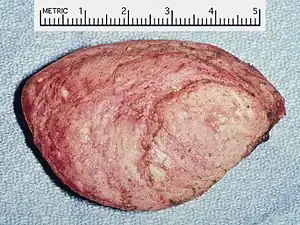Rhabdomyoma
| Rhabdomyoma | |
|---|---|
 | |
| Surgically excised cardiac rhabdomyoma (unfixed) | |
| Types | Adult, fetal, genital[1] |
| Frequency | Rare[1] |
A rhabdomyoma is a noncancerous tumor of skeletal muscle.[1] Most arise in the head and neck and present as slow growing masses that usually do not hurt.[1] There may be a hoarse voice, obstructive sleep apnea, loss of hearing and difficulty swallowing.[1] In the female genitalia, it may present with heavy menses or appear as a vaginal polyp.[1] In the male genitalia, it may appear as a scrotal lump.[1]
There are three distinct types: adult type, fetal type, and genital type.[1] The metal type typically occurs in association with basal cell nevus syndrome.[1] Treatment is by surgical excision, but if not cut out completely, may recur.[1]
It is rare.[1] The adult type is the most common with males affected three times more than females and with an average age of over 60-years. Fetal type is twice as frequent in males than females with an average age of 2-years.[1]
Features
Cardiac rhabdomyomas are the most common primary tumor of the heart in infants and children. It has an association with tuberous sclerosis.[2] In those with tuberous sclerosis, the tumor may regress and disappear completely, or remain consistent in size. A common histological feature is the presence of Spider Cells, which are cardiac myocytes with enlarged glycogen vacuoles separated by eosinophilic strands, resembling the legs of a spider.
It is most commonly associated with the tongue,[3] and heart,[4] but can also occur in other locations, such as the vagina.[5]
Malignant skeletal muscle tumors are referred to as rhabdomyosarcoma. Only rare cases of possible malignant change have been reported in fetal rhabdomyoma. The differential diagnosis in the tongue includes ectomesenchymal chondromyxoid tumor.[6]
Additional images

References
- 1 2 3 4 5 6 7 8 9 10 11 12 WHO Classification of Tumours Editorial Board, ed. (2020). "1. Soft tissue tumours: skeletal muscle tumours - rhabdomyoma". Soft Tissue and Bone Tumours: WHO Classification of Tumours. Vol. 3 (5th ed.). Lyon (France): International Agency for Research on Cancer. pp. 198–200. ISBN 978-92-832-4503-2. Archived from the original on 2021-06-13. Retrieved 2022-06-25.
- ↑ Bader RS, Chitayat D, Kelly E, et al. (November 2003). "Fetal rhabdomyoma: prenatal diagnosis, clinical outcome, and incidence of associated tuberous sclerosis complex". J. Pediatr. 143 (5): 620–4. doi:10.1067/S0022-3476(03)00494-3. PMID 14615733.
- ↑ Pérez-Alonso P, Sánchez-Simón R, Contreras F, Patrón-Romero M (December 2000). "Special feature: pathological case of the month. Denouement and discussion: fetal rhabdomyoma of the tongue (myxoid type)". Arch Pediatr Adolesc Med. 154 (12): 1265–6. doi:10.1001/archpedi.154.12.1265. PMID 11115314.
- ↑ Sugiyama H, Naito H, Tsukano S, Echigo S, Kamiya T (November 2005). "Evaluation of cardiac tumors in children by electron-beam computed tomography: rhabdomyoma and fibroma". Circ. J. 69 (11): 1352–6. doi:10.1253/circj.69.1352. PMID 16247210.
- ↑ Edward F. Goljan (2009). Pathology (Third ed.). Elsevier. p. 537.
Tumour Type: Rhabdomyoma; Location: Heart, also tongue and vagina; Comment: Benign heart tumour associated with tuberous sclerosis
- ↑ Smith BC, Ellis GL, Meis-Kindblom JM, Williams SB (May 1995). "Ectomesenchymal chondromyxoid tumor of the anterior tongue. Nineteen cases of a new clinicopathologic entity". Am J Surg Pathol. 19 (5): 519–30. doi:10.1097/00000478-199505000-00003. PMID 7726361. S2CID 21161742. Archived from the original on 2022-07-06. Retrieved 2022-04-19.
| Classification | |
|---|---|
| External resources |